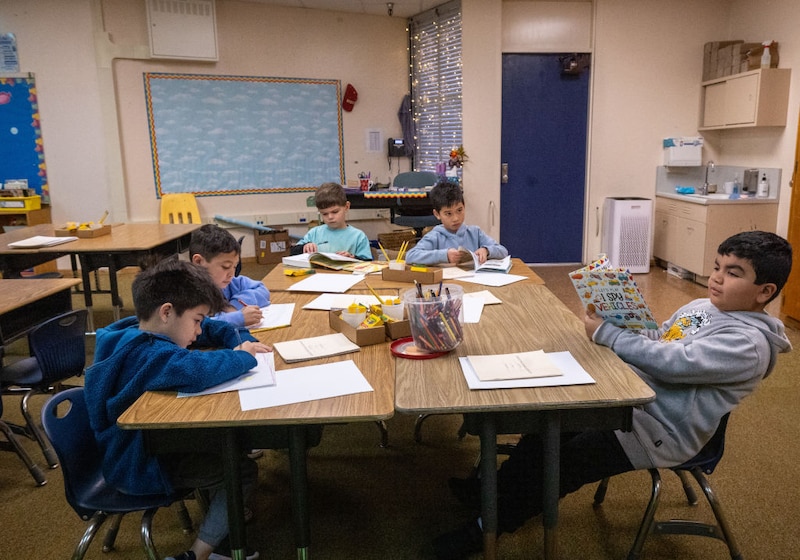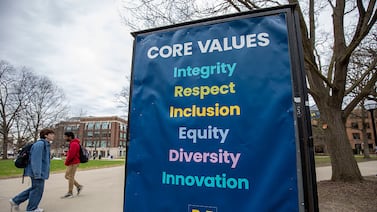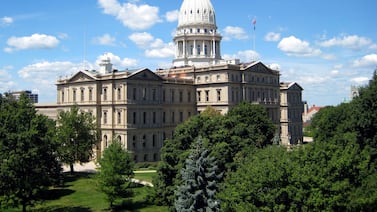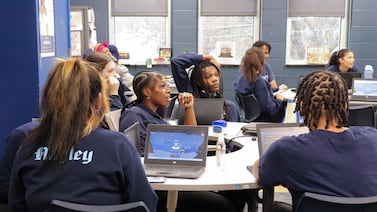Sign up for Chalkbeat’s free weekly newsletter to keep up with how education is changing across the U.S.
With a series of sweeping executive actions, President Donald Trump is seeking to remake K-12 education in a conservative image. In the process, he’s pushing legal and political boundaries on how far the federal government can reach into American classrooms.
But the executive orders on their own have little power to radically and rapidly change an American school system in which states, school districts, and even individual schools have traditionally called the shots on everything from what kids learn to which restroom transgender students use.
Some conservatives are cheering the new approach — one they believe better reflects the views of most Americans. Many left-leaning education advocates and those who champion traditional public schools say the executive orders have little legal power.
It will likely take months for the full impact of the executive orders to be clear.
In the first two weeks of his second term, Trump said the federal government would only recognize two sexes, male and female, which could have big implications for transgender students’ rights. He wants to root out “radical indoctrination” in American classrooms and send more federal funding to private school vouchers.
He also cleared the way for immigration arrests at schools, and sought to freeze certain federal funds for schools and early childhood programs. The administration continues to selectively block payments to programs it deems not aligned with its values or policy priorities in the face of numerous legal challenges.
Taken together, these actions show the Trump administration is ready to lean on various levers of power — from the bully pulpit to federal investigations to threats of withholding funding — to convince or coerce schools to comply with its worldview, whether or not the federal government has the legal authority to do so. Disappointing national test scores and state-level wins for Republicans could also be fueling Trump’s ambitions to stake a greater political claim on K-12 education.
“The president is responding to what he feels like the voters who put him in office feel strongly about,” said Jonathan Butcher, a senior research fellow in education policy at The Heritage Foundation, a conservative think tank whose policy proposals are often embraced by Trump. “It sort of changed the mission statement on these issues of gender, race, down to school choice, and beyond. That’s an important starting point.”
Some effects were swift. The U.S. Department of Education removed hundreds of documents from its website related to diversity and equity initiatives and suspended at least 50 staffers. Civil rights staffers are now enforcing 2020 Title IX rules, which don’t offer explicit protections for trans students as did now-defunct rules issued under President Joe Biden. And some schools have seen attendance dip among immigrant students whose families worry they could be detained by immigration agents during school dropoff.
Some of the high-profile orders have had little or no tangible effect on schools so far. They direct federal agencies, not states or districts, to develop plans over the next several months. At the same time, some observers worry schools will preemptively make changes to their teaching or programs — even if they aren’t legally required to.
The executive orders “have a lot of power to create chaos and fear and confusion, and that’s real, immediately,” said Ary Amerikaner, a former Education Department official and the executive director of Brown’s Promise, which conducts research and advocacy on school desegregation and school funding. Yet she also said Trump’s actions were “mostly bluster” that lacked “a lot of power to actually affect what’s happening on the ground, because they can’t change existing law.”
The orders leave a lot of room for interpretation, several education policy experts said. Forthcoming guidance and federal grant notices could help fill in blanks.
“I want details,” said Noelle Ellerson Ng, who oversees advocacy and governance for The School Superintendents Association. “How do these proposals continue to roll out?”
The executive actions also highlight an ongoing tension in the Trump administration’s approach to K-12 education.
Trump and his allies have said they want to shrink the size and role of the federal Education Department, if not abolish it entirely. Trump is reportedly preparing an executive order to diminish the department’s size. But his orders so far indicate a certain desire to wrest power from local schools by dictating what they can and cannot teach about topics such as systemic racism, white privilege, and gender identity. Numerous laws prohibit federal officials from deciding what program of instruction or curriculum a school uses, which some state officials have been keen to point out.
The incoming education secretary has been tasked with issuing several reports on how various executive orders could be carried out. Yet attempts by Trump officials to directly control daily school decisions could quickly trigger lengthy court battles.
“They’re not the nation’s school board,” Ellerson Ng said.
Trump order has potential effects on classroom instruction
Some worry Trump’s executive order seeking to withhold federal funds from schools that teach “discriminatory equity ideology” or “gender ideology” has the potential to alter classroom instruction and cut support for trans students.
The order defines “discriminatory equity ideology” as any classroom instruction that treats people “as members of preferred or disfavored groups, rather than as individuals, and minimizes agency, merit, and capability.” It has the same acronym — DEI — as the “diversity, equity, and inclusion” efforts Trump is seeking to eliminate throughout the federal government.
“Gender ideology,” meanwhile, includes any instance in which a school recognizes that a child can be a gender other than the male or female sex they were assigned at birth. It targets classroom instruction, as well as counseling for students and school policies, such as those asking teachers to use the name and pronouns that correspond with a child’s gender identity.
The order seeks to stop schools from teaching that people can be inherently racist, sexist, privileged, or oppressed based on their race, sex, or other characteristics — taking direct aim at concepts such as white privilege and unconscious bias. It also seeks to bar teaching that the U.S. is fundamentally racist, a concept that about 1 in 3 students says comes up often at their school, a recent nationally representative survey of high schoolers found.

The language mirrors the text of several state laws that target critical race theory, an academic concept that says racism is embedded in the U.S. legal system and government policies.
Eighteen states already have laws or official policies that prohibit similar lessons. But there is reason to believe some teachers will self-censor or face new pressures from their district or school leaders. It’s happened before.
A 2022 national survey, for example, found that 1 in 5 teachers in states without official limits on teaching about racism and sexism were asked to curtail discussion of hot-button social and political topics.
“This administration is clearly thriving in a culture of creating fear,” said Amerikaner, of Brown’s Promise. “The thing that I think is most important for educators and administrators on the ground is to not take the bait.”
Similarly, advocates for LGBTQ students are advising schools they don’t need to change their policies because of the president’s order.
“School districts need to be aware that LGBTQ students’ rights have not changed,” said Brian Dittmeier, the director of public policy at GLSEN, an organization that works to create safe school environments for LGBTQ youth.
Trans kids and other LGBTQ students still have various protections under the U.S. Constitution and federal civil rights laws. And state laws that protect LGBTQ students remain in effect in those states.
Executive orders don’t reverse case law, Dittmeier said. Regardless of shifting Title IX regulations, court cases such as Grimm v. Gloucester County School Board held that transgender students have a right to use the restroom that aligns with their gender identity. And the U.S. Supreme Court found in Bostock v. Clayton County that discrimination against gay or transgender people is a form of sex discrimination, although pending cases have the potential to change the legal landscape.
In a Jan. 31 letter to education officials, a Trump official said the reinstated 2020 Title IX rules do not protect students from discrimination based on sex stereotypes.
Still, schools that fail to protect LGBTQ students’ rights in an effort to comply with Trump’s executive order could be subject to lawsuits and civil rights complaints, including in the 26 states that have their own civil rights processes, Dittmeier said.
Landscape for education civil rights complaints could change
To Butcher, of the Heritage Foundation, the executive order about “discriminatory equity ideology” is asking schools to follow existing anti-discrimination laws.
He envisions, for example, that there could be a federal civil rights investigation if a school grouped students into affinity groups by race or limited discipline for Black and Hispanic students as a way to meet internal “ratios” and avoid suspending too many students of color. That could have prompted a civil rights probe under now-rescinded Obama administration guidance.
How exactly the Trump administration will monitor whether schools are violating the executive order remains to be seen.
Conservative parent groups file frequent federal civil rights complaints objecting to teacher diversity programs and student affinity groups. Under Trump, these complaints could get a friendlier reception.
Even under the Biden administration, the Los Angeles school system was forced to overhaul a program to promote Black student achievement in response to such a complaint.
The Trump Education Department has already taken a step on a related issue: It has dismissed 11 civil rights complaints related to alleged book bans, which the agency labeled a “hoax.”
Some states with similar prohibitions set up a reporting process so parents, school staff, and others can flag materials or lessons that may not comply with state law.
But creating a national reporting tool would be logistically challenging and time-consuming, said Butcher, who wants to see the Department of Justice take the lead on investigating with help from state education officials and state attorneys general.
“Not every report or accusation is accurate,” Butcher said. “There is a lot of follow up that has to be done. That, I think, is beyond the scope of what Washington should be doing right now, especially at the Department of Education, if the goal is to be winding it down.”
School districts may also decide to be extra cautious with their budgets to avoid the risk of losing federal funds if they somehow violate a presidential order.
Sarah Abernathy, the executive director of the Committee for Education Funding, which tracks federal investments in education on behalf of several groups, said she’ll be listening for school district discussions about laying off staff or ending programs to comply with a federal order — or get ahead of one.
She also worries schools will be afraid to talk about it publicly for fear of drawing any attention to themselves. On a recent call with members of her organization, Abernathy asked for examples of how the presidential orders could affect K-12 schools financially and all she heard was “crickets.”
“I don’t think anyone in the education world wants the administration using them as an example of something that is wrong,” she said.
Kalyn Belsha is a senior national education reporter based in Chicago. Contact her at kbelsha@chalkbeat.org.
Erica Meltzer is Chalkbeat’s national editor based in Colorado. Contact Erica at emeltzer@chalkbeat.org.





